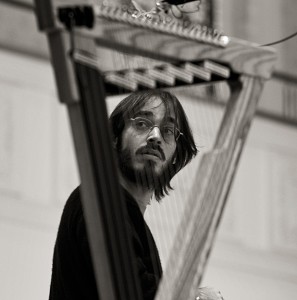 Presented by Adelaide Festival in partnership with Adelaide Symphony Orchestra
Presented by Adelaide Festival in partnership with Adelaide Symphony Orchestra
Reviewed 11 February 2014
From the temperate opening to the structure-moving conclusion, Tectonics part 2, was a day of extremes in which Ilan Volkov and his artists brought all the literal and figurative bells and whistles to the superb Queen’s Theatre.
The inventive Speak Percussion opened with Riti: I funerali d’Achille by Giacinto Scelsi, performed by Louise Devenish, Matthias Schack-Arnott, Leah Scholes and Eugene Ughetti.
Next, the world premiere of the outstanding Whorl Would Equal Reaches, composed by James Rushford (attending), with Jamie Adam, Devenish, Schack-Arnott, Scholes, Vanessa Tomlinson, and Ughetti. Speak Percussion (commissioners), with telepathic-like communication, delivered the greatest of complexities in the quietest of pianissimos. Bottles, aerosols, pens and voice-over were utilised, ending in an inspired tableau.
Redefining the word ‘understated’, Crys Cole then graced the solo stage, playing to an audience transfixed. Producing fascinating sounds, she very cleverly took us on a journey, rondo style, which finished right back at the beginning.
Three off-centre stage blocks elevated the astounding “Hammers Lake”. The brilliant Carolyn Connors (vocals) and Judith Hamann (‘cello), were joined for this performance-art feast by the fabulous Tomlinson (percussion). Anguish met joy and unique use of aluminium foil, in this Festival highlight.
Evraiki by Robbie Avenaim (stage percussion) was a clear audience favourite. Anna Coleman (bass clarinet), Connors (vocals), flautists Jim Denley and Rebecca Johnson, Harley Gray (double bass), Hamann (‘cello), violinists Anna McMichael and Erkki Veltheim, Rushford (viola), and percussionists Devenish, Schack-Arnott, Scholes, and Ughetti presented an altogether different perspective, like wandering minstrels in days of yore, taking a dérive, with wonderful results.
Guitarists Oren Ambarchi and Stephen O’Malley performed Criss-Cross, composed by the prolific experimental composer, Alvin Lucier; the pure wave oscillations providing a meditative effect, readying the audience for the massive and exceptional TEMA by Marco Fusinato, which literally shook me.
Ambarchi and O’Malley then world premiered South Pole by Iancu Dumitrescu. Complete with smoke screen, this dynamic and uplifting piece was conducted forwards and backwards by Volkov who, with the guitarists, upstaged the percussionists.
Veltheim showcased his technical prowess in the mournful and sweet Mikka and Mikka s by Iannis Xenakis, followed immediately by Scelsi’s powerful Riti : I funerali di Carlo Magno (A.D. 814), by Hamann and Ughetti. Next, Volkov conducted Okanagon, by Scelsi; the melodic and percussive instruments of Gray, Amanda Grigg (percussion) and Suzanne Handel (harp) producing metallic and ethereal timbre.
Composer Veltheim spoke in tongues with Glossolalia, performing with his loved/hated string quartet of McMichael, Graeme Jennings (violin), and Hamann. The self-assessed “chaotic homage to modernist dreams” deconstructed until it fell over, apparently using Velteim’s morse code conversion of Ludwig Wittgenstein’s Tractatus Logico-Philosophicus, as his very particular type of humour. The resultant de-tuned strings, pops, whizzes and scratches gave us an intricate, delicate and furious delight guised as organised chaos.
Legendary Fluxus artist Takehisa Kosugi, made his first Australian trip memorable for audiences with his intricate solo piece that literally lit the stage, for which he received a standing ovation and cheers.
Joel Stern then beckoned the audience to gather around his desk for the amazing solo carnival 2014, a quadraphonic multi-sensory piece using synthesizers and LED lights which expertly utilised the massive sound system.
Our first glimpses of Attila Csihar were robed, hooded and cleric-like at a purple neon desk performing Void Ov Voices, which was neither void of voices or relevance. Dark, disturbing and incredible, with undertones of plainsong and Sufi music and overtones of malevolence; the layers cleverly all Csihar’s voice.
In a complete change of pace, the incomparable Ikue Mori took performance art to a high with Nymphs, witches and fairies. Beautiful and clever imagery married serene and dramatic sound-scapes to graphic landscapes. Aspects of architecture, puppetry and pantomime visualised with hints of mythology and nature and, my favourite, la calaca loca’s skull clock.
As those around me spoke expectantly of “face-melting metal”, the hard-core enthusiasts got up close and personal to the stage for the colossal finale that was a unique experience. Ambarchi, Csihar and O’Malley performed as Gravetemple to the intense appreciation of their die-hard fans. ‘Awesome’ and ‘mind-blowing’ don’t do the trio’s side-project justice.
The technical crew deserve a second mention for the mammoth job in putting Tectonics together.
Volkov’s pre-Tectonics press release ended with the wish that he, “hope’s we have a blast”. Well played Maestro. Mission accomplished.
Reviewed by Gordon Forester
Venue: Queen’s Theatre, Playhouse Lane, Adelaide
Season: 10 – 11 March 2014
Duration: 9 hours
- Adelaide Festival website
- Alvin Lucier website
- Anna McMichael website
- Attila Csihar website
- Carolyn Connors website
- Crys Cole website
- Erkki Veltheim on soundcloud
- Hammers Lake website
- Ikue Mori website
- Ilan Volkov biography
- James Rushford website
- Jim Denley website
- Joel Stern website
- Judith Hamann website
- Louise Devenish website
- Marco Fusinato website
- Matthias Schack-Arnott
- Oren Ambarchi website
- Robbie Avenaim website
- Speak Percussion website
- Stephen O’Malley website
- Suzanne Handel website
- Vanessa Tomlinson website




















